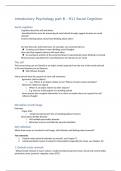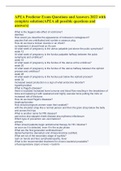Summary
Summary Chapter 11 of the book Psychology - Introductory Psychology and Brain & Cognition (7201702PXY)
- Course
- Institution
- Book
In this summary of chapter 11 of Psychology from Gray and Bjorklund the most important terms are explained in bullet points and the pictures from the book are included. Also the page numbers are included so if you need to study some more on certain terms you can easily look it up in the book. Impor...
[Show more]













